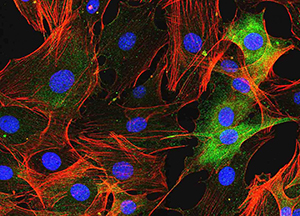LA JOLLA, CA — Researchers at the La Jolla Institute for Immunology, in collaboration with colleagues the University of California, San Diego, identified a novel drug target for the treatment of rheumatoid arthritis that focuses on the cells that are directly responsible for the cartilage damage in affected joints.
Their findings, published in the May 20, 2015 issue of Science Translational Medicine, could open the door to an entirely new class of medications that specifically prevents joint damage and brings relief to patients who don’t respond to available treatment regimes.
Current rheumatoid arthritis treatments focus on intercepting the immune system’s misdirected attack on the lining of affected joints to alleviate the debilitating symptoms, reduce inflammation and slow the progression of the disease. “Unfortunately, for around 40 percent of patients, immune-targeted therapies are not sufficient to bring them into full remission,” says the study’s lead author Nunzio Bottini, M.D. Ph.D., associate professor at La Jolla Institute and associate professor of Medicine at the University of California, San Diego. “If we could add a drug that acts on a different target without increasing immune suppression it could be very valuable.”
Rheumatoid arthritis, an autoimmune disease that leads to stiff, deformed joints and often crippling pain, affects around 1.5 million adults in the United States. The immune system’s attack on the body’s own tissue leads to chronic, painful inflammation in the affected joints. The inflammatory processes also activate fibroblast-like synoviocytes (FLS), specialized cells that line the inside of joints providing lubrication and repairing joint injuries. Once mobilized, however, the formerly quiescent FLS invade the surrounding cartilage and secrete enzymes that break down the firm, rubbery tissue that cushions the bone. In addition, they trigger bone destruction.

“Even if your inflammation is completely under control with the help of current therapies — and they are excellent — the damage to the skeletal structure is not necessarily arrested in the long term because synoviocytes continue to cause damage,” explains Bottini. “And although synoviocytes are considered the main effectors of cartilage damage in rheumatoid arthritis there’s no therapy directed against them.”
The behavior of FLS is governed by intracellular signaling cascades, which rely on the presence (or absence) of small phosphate groups to transmit signals through the cell. These phosphate groups are attached to proteins by enzymes known as kinases, while phosphatases act as their counterparts by removing them. Changing a signaling molecule’s phosphorylation status elicits specific changes in the molecule’s activation status.
When postdoctoral researcher and first author, Karen M. Doody, Ph.D., screened samples from rheumatoid arthritis patients for the expression of phosphatases, she discovered that an enzyme known as RPTPσ, short for receptor protein tyrosine phosphatase sigma, is highly expressed on the surface of FLS.
Normally, RPTPσ sits quietly on the surface of synoviocytes. It is kept inactive through its interaction with specialized carbohydrate-protein assemblies called proteoglycans, which are studding the cells’ surface at high density. When freed from the proteoglycans’ grip, RPTPσ snaps into action and weakens the ability of arthritic synoviocytes to aggressively invade the joint’s cartilage. “RPTPσ acts like an inhibitory signal that is precoded on the surface of these cells,” explains Doody, whose goal was to take advantage of this natural brake.
She and her colleagues then successfully released the brake by blocking the interaction between the phosphatase and proteoglycans with a biological decoy. When she added small pieces of the phosphatase’s extracellular domain to synoviocytes, the fragments occupied the binding sites on the proteoglycan molecules and thus prevented them from sequestering the phosphatase. As a result, cells became less invasive and lost their tendency to attach to cartilage. When administered to a preclinical model of arthritis, the phosphatase decoy ameliorated the symptoms of their disease. “Being able to activate RPTPσ’s activity gives us a specific tool with which to adjust the migration and aggressiveness of synoviocytes in rheumatoid arthritis,” she says.
“The unique aspect of this approach is the ability to improve symptoms and decrease joint damage while potentially avoiding any negative effects on normal immune responses and susceptibility to infections,” adds co-author Gary S. Firestein, M.D., dean and associate vice chancellor of Translational Medicine and director of the Clinical and Translational Research Institute at UCSD.
Currently, Doody is testing in preclinical models whether combining this agent with other, known rheumatoid arthritis treatments results in more efficacious therapies. Explains Bottini, “The ultimate goal is to use biologics that target synoviocytes in combination with treatments that suppress the immune system, such as methotrexate or anti-TNF, to address all three aspects of rheumatoid arthritis: swollen joints as a result of inflammation, cartilage damage and bone damage.”
This work was funded in part by the La Jolla Institute for Immunology, the National Institutes of Health NIH (AR066053, AR47825, AI070555, UL1TR000100, AR064202) the Canadian Institutes for Health Research and the Juvenile Diabetes Research Foundation.
Full citation: “Targeting phosphatase-dependent proteoglycan switch for rheumatoid arthritis therapy” Karen M. Doody, Stephanie M. Stanford, Cristiano Sacchetti, Mattias N. D. Svensson, Charlotte H. Coles, Nikolaos Mitakidis, William B. Kiosses, Beatrix Bartok, Camille Fos, Esther Cory, Robert L. Sah, Ru Liu-Bryan, David L. Boyle, Heather A. Arnett, Tomas Mustelin, Maripat Corr, Jeffrey D. Esko, Michel L. Tremblay, Gary S. Firestein, A. Radu Aricescu, and Nunzio Bottini. Science Translational Medicine, 2015
About the La Jolla Institute for Immunology
The La Jolla Institute for Immunology is dedicated to understanding the intricacies and power of the immune system to that we may apply that knowledge to promote human health and prevent a wide range of human diseases. Since its founding in 1988 as an independent, nonprofit research organization, the Institute has made numerous advanced leading toward its goal: life without disease.


